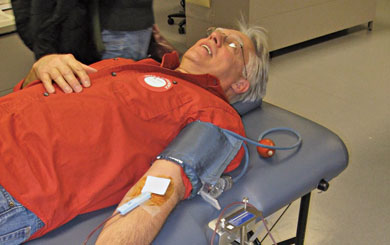
I give blood when I can. I’m not going to set any records for donations, but the drops and pints are adding up, and I feel good about doing something good.
For men, there is a lifesaving benefit to this modern bloodletting. We are at higher risk for “iron overload,” a potentially deadly problem where too much iron builds up in the blood. It can lead to heart disease and other major health problems. Donating blood regularly—the Red Cross lets you donate whole blood every 56 days—reduces that iron buildup, which women experience naturally through their periods. That could partly explain why women tend to live longer than men.
Donating blood is safe and healthy. You’ll drop about a pound, and get a free mini physical, including blood pressure check, heart rate, temperature and iron levels.
Ironically, I once found out I was anemic through a pre-bloodgiving physical.
I admire the Red Cross, so I was upset when someone told me it sells my blood for $500 or more to keep its staff highly paid. That didn’t seem right to me. Why should the Red Cross make money off the blood I donated? I meant it to be given to people who need it—at no charge. lf they sell it, they might as well pay me for it, right?
It turns out that the Red Cross doesn’t charge for my blood, nor do they pay people to donate. The misinformation, which continues to circulate like an old joke, is dispelled on their website, redcrossblood.org, where it clearly states:
“Since 1960, the Red Cross has been reimbursed by hospitals for the costs associated with providing blood to hospital patients. The Red Cross does not charge for the blood itself that you have so generously donated. The Red Cross only recovers the costs associated with the recruitment and screening of potential donors, the collection of blood by trained staff, the processing and testing of each unit of blood in state-of-the-art laboratories, and the labeling, storage and distribution of blood components. Hospitals may have their own additional charges.”
Now that we have the internet and can find the news and information we want to believe, rather than facts that are uncomfortably true, this kind of misinformation is rampant. We’re often too ready to believe any goofy report that somehow validates our preconceived notions of how the world works.
As another example, a friend recently forwarded an email from another friend about an article supposedly printed in the Marquette Mining Journal a few years ago. The article, with all of the weird punctuation and grammar intact, went as follows:
“Up here in the Northern part of Michigan we just recovered from a Historic event — may I even say a “Weather Event” of “Biblical Proportions” — with a historic blizzard of up to 44” inches of snow and winds to 90 MPH that broke trees in half, knocked down utility poles, stranded hundreds of motorists in lethal snow banks, closed ALL roads, isolated scores of communities and cut power to 10’s of thousands. And guess what; no one howled for the government. FEMA was not called on to send assistance. Our Mayor’s did not blame the President or anyone else. Our Governor did not blame anyone either. CNN, ABC, CBS, FOX, or NBC did not visit – or even report on this category 5 snow storm.
“No one looted. Nobody – I mean Nobody demanded the government do something. Nope, we just melted the snow for water. Sent out caravans of SUV’s to pluck people out of snow engulfed cars. The truck drivers pulled people out of snow banks and didn’t ask for a penny.”
If that tortured text didn’t convince you, the email had amazing photos of snow drifts that towered over road crews.
A little research showed that versions of the story have been circulating on the internet for several years.
The “facts” are that the weather report did not come from northern Michigan, nor was it reported in the Mining Journal. It can be traced back to an October 2005 snowstorm that hit the Dakotas, Montana and Wyoming. A national weather service report stated the storm was the earliest to hit the area on record. A request did in fact go to FEMA seeking assistance. As for hearty citizens plucking stranded motorists from their cars, that probably did happen, but the bulk of the digging out fell to police, emergency workers and the National Guard, which were mobilized to help, as often happens following serious weather events. As for the pictures, it turns out they were from the opening of the Trans Labrador Highway in northeastern Canada and were circulating the internet in 2004.
As with many of these shared emails, the combination of distorted fact, exaggeration and government put-down took on a life of its own. It bothers me that we seem eager to embrace this pseudo-journalism and put down the mainstream media, which at least has the virtue of checking facts before reporting them—even if the public doesn’t like them.
Here’s a fact for you to chew on: 60 percent of the population will need blood at some time in their lives, yet less than 5 percent of the population donates. If discredited rumors about Red Cross mischief is the reason you don’t donate blood, please ignore them. One donation can help four people live. I’d say that’s a good investment.
Mike Buda is editor emeritus of Country Lines. Email Mike at mike.f.buda@gmail.com or comment on his columns at countrylines.com.



